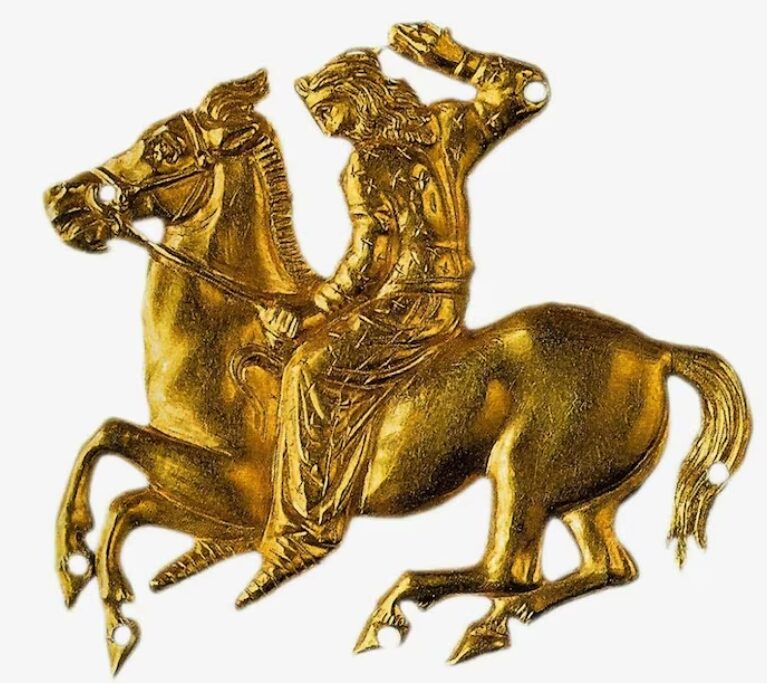Ancient nomads known as the Scythians did indeed use human skin for the containers that held their arrows—confirming the account of the ancient Greek historian Herodotus, who is often questioned about the fantastic accounts he recorded more than 2, 400 ago. “Our results appear to confirm Herodotus’ grisly claim,” declare the researchers who made the discovery, recently published in the journal PLOS ONE. According to Herodotus, the Scythians not only drank the blood of the first man they killed and collected the scalps of their enemies: “Many too take off the skin, nails and all, from their dead enemies’ right hands, and make coverings for their quivers; the human skin was, as it turned out, thick and shining, the brightest and whitest skin of all, one might say,” the historian wrote in the 5th century B.C. Researchers confirmed the quiver claim after analyzing 45 fragments of leather and two fragments of fur from 13 previously excavated 2,400-year-old Scythian burial mounds, or kurgans, in southern Ukraine. They used a technique known as peptide mass fingerprinting to examine distinctive proteins in the fragments (collagen for skin and keratin for fur) and identify the animal species in 36 of the 45 leather fragments—including two that definitely came from Homo sapiens. Both human samples came from leather used for arrow quivers, just as Herodotus described. “We only have two examples, but two is better than one or none,” says senior study author Margarita Gleba, an archaeologist at Italy’s University of Padua. “So there has to be something to what Herodotus tells us, and clearly the Scythians did use human skin to produce cultural artifacts.”
The scraps of leather are too small to determine whether they were fashioned from human hands, but future DNA analysis might yet reveal where the people sourced for the leather came from. Gleba says it appears that human skin was only used for the tops of the quivers, while lower parts were made from more “ordinary” leather, like that of cattle or wild animals like foxes. “They’re very often combining leather from different animals, and sometimes from humans as well,” she says. “It was a matter of what they had available.”
Herodotus devoted almost a whole book of his nine-volume Histories to the Scythians, who were his contemporaries when he wrote in the fifth century B.C, describing them as nomads living in the lands north of the Black Sea. Archaeological evidence for Scythians and related nomad groups, however, has been found across the Eurasian steppe from Ukraine to western China. Archaeogeneticist Guido Gnecchi Ruscone of the Max Planck Institute for Evolutionary Anthropology in Leipzig, Germany, who has studied the Scythians but was not involved in the latest research, says they seem to have originated in the Altai Mountains of eastern Kazakhstan in about 900 B.C. The Greek historian noted the Scythians were renowned for their warrior ways, and that short bows—for both warfare and hunting—were an important feature of Scythian life.
Archaeologist Barry Cunliffe of the University of Oxford, an expert on the Scythians who was not involved in the study, says Herodotus likely gained his information during his visit to Olbia, a Greek colony on the northern shore of the Black Sea, around 444 B.C.. “He would have sort of talked to a lot of people there and picked up various stories, which he spliced together,” Cunliffe says. As a result, what Herodotus reported was likely true—but not all Scythians may have always shared the same practices: “He’s merging this rag-bag of information.” Cunliffe suggests that using human skin on a quiver may have been an attempt to magically imbue the arrows within: “You’re controlling the power of your enemy, through having a bit of him there.”
The Roman orator Cicero called Herodotus “the Father of History” but he’s also been called “the Father of Lies” by classical scholars for some of his more outlandish accounts, including gold-digging, fox-sized ants; winged snakes; and a race of one-eyed Europeans who steal gold from griffins. But this latest discovery further vindicates Herodotus, says Carolyn Dewald, professor emeritus of classical studies at Bard College who wasn’t involved in the latest study.” (National Geographic)
The scholar mentioned above who postulated that the Scythians might have originated in the Altai Mountains did nor seem to read Herodotus. Read What Herodotus Wrote About Scythian Origin >
The “Royal Scythia, Greece, Kyiv Rus” book has many more little-known facts about the Scythians, their culture and art.
